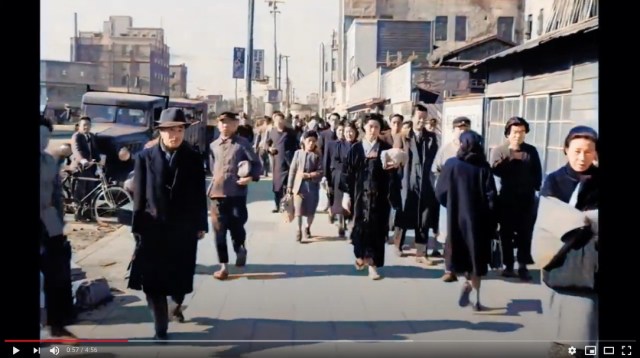
Originally used as the background for Humphrey Bogart’s close-up, these Japanese folks are now having their time in the spotlight.
It’s always fascinating to go back in time and look at footage of old Japan, and now that we’ve got access to advanced digital technology, life as it was in the past has the ability to look crisper and sharper than it ever has before.
One old clip that resurfaced recently is a perfect example, showing how much of a difference colour can add to a previously black-and-white film. And this isn’t just any ordinary film — it’s footage taken for the 1949 Hollywood movie Tokyo Joe, starring American actor Humphrey Bogart as the titular character.
▼ Take a look at the original black-and-white clip here:
Tokyo Joe was the first movie company permitted to film in Japan after World War II. It’s amazing to think that the footage above was captured in 1948, during Japan’s Showa Period (1926-1989), just three short years after the atomic bombings of Hiroshima and Nagasaki in 1945.
▼ The streets above were used as background scenery for Bogart’s character in the movie.
A blend of kimonos, suits, and soldier’s uniforms can be seen during these street scenes, reflecting the changing times of the period. In 1948, Japan was emerging from almost a century of Imperial rule, which ended when the Emperor surrendered to The Supreme Commander for the Allied Powers, General Douglas MacArthur, in 1945.
The street scenes act as a far more engaging lesson in history than anything you’d find in a textbook, and even more so when it’s been retouched in brilliant colour.
▼ Take a look at the beautiful colourised version below:
The colourised clip was created with AI technology, specifically a program called DeOldify, which uses deep learning to colourise and restore old images and videos. The difference between the two clips is remarkable, with the colourised version drawing us in to the scene in a much more meaningful way, making us feel as if this could be a real place that exists today.
While the classic cars and street signs are amazing to look at, the fashions on the street are equally mesmerising.
▼ A particularly handsome couple.
Looking at the street signs, we can see that the clip was shot in Shibuya, with signs for 道玄坂百貨街 (“Dogenzaka Department Store”) and カワシマ帽子店 (“Kawashima Hat Store”) revealing this was taken in the Dogenzaka area, specifically where Shibuya Prime stands today, next to the famous 109 building.
▼ Google Maps doesn’t go back to 1948, unfortunately, but the now-closed Hooters was housed in the Prime Building until recently.
Bogart himself didn’t actually come to Japan to film the scenes at Shibuya, with a stand-in hopping into the real “Tokyo Cycle-car”, which turns the corner at Sakae Dori, outside what is now the 109 building.
While Bogart was the original star of Tokyo Joe, 72 years later, it’s the background scenes that have stolen the limelight with their mesmerising view of everyday life in Tokyo in the late ’40s. It’s a very different Shibuya to the one we know today, with its bright lights, huge screens and busy scramble crossing, but it’s nice to see that even back then it was a hive of activity, with tightly cramped stores and fashionable pedestrians walking the streets.
And just three years after this footage was taken, the build-up of Shibuya as a city within a city really began, with the introduction of a sightseeing cable car above what is now Shibuya Station.
Source: YouTube/pcmeister11 via Japaaan
Featured image: YouTube/pcmeister11
Insert images: YouTube/pcmeister11, YouTube/LindafulLinda
● Want to hear about SoraNews24’s latest articles as soon as they’re published? Follow us on Facebook and Twitter!

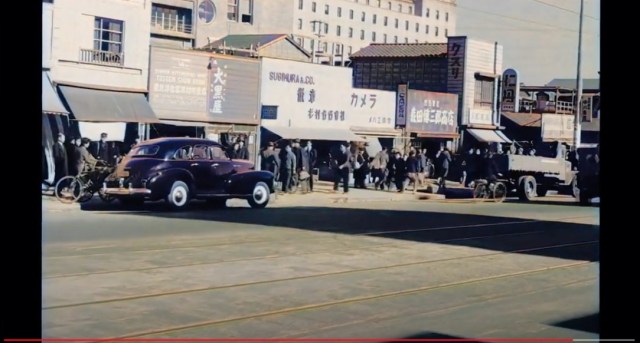
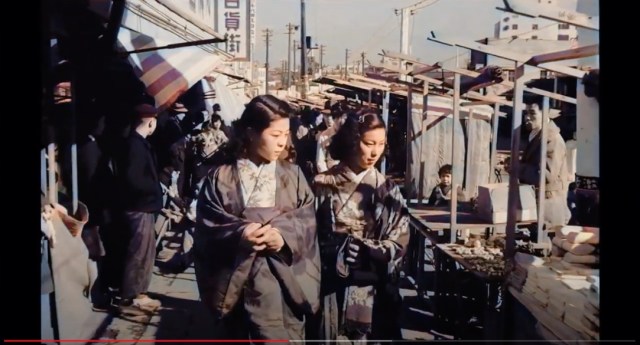
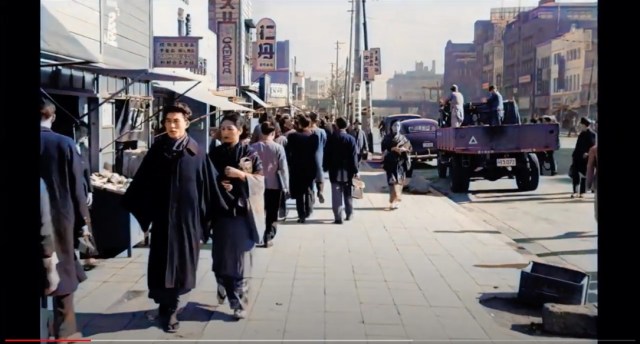
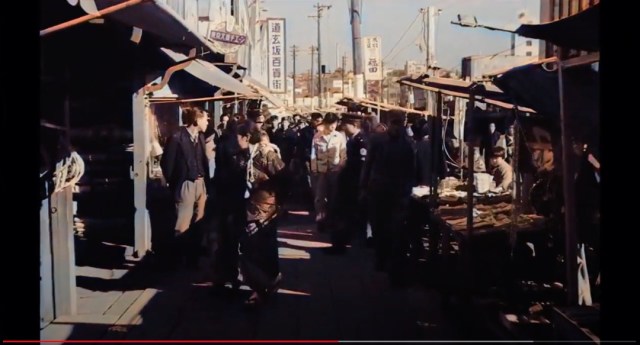
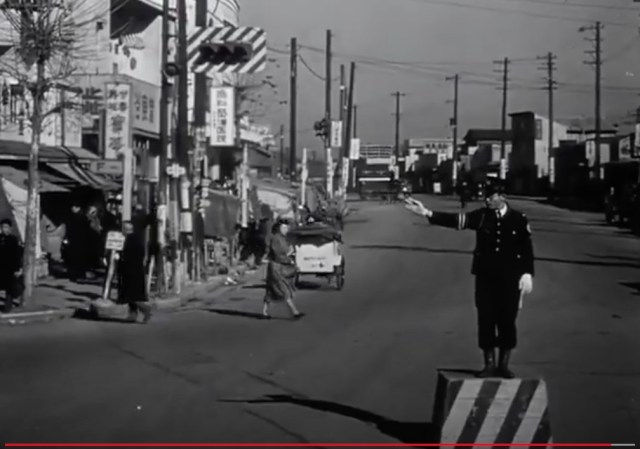
 New Adidas Hachiko sneakers pay homage to Shibuya’s famous loyal dog
New Adidas Hachiko sneakers pay homage to Shibuya’s famous loyal dog National Film Archive of Japan releases shocking historical videos of 1923 Great Kanto Earthquake
National Film Archive of Japan releases shocking historical videos of 1923 Great Kanto Earthquake Shibuya rats scuttle along streets in the wake of Typhoon Hagibis【Video】
Shibuya rats scuttle along streets in the wake of Typhoon Hagibis【Video】 Brand-new Tokyo Shibuya Scramble intersection opens…but over 50 miles away from Tokyo?!【Photos】
Brand-new Tokyo Shibuya Scramble intersection opens…but over 50 miles away from Tokyo?!【Photos】 McDonald’s at Shibuya Center-gai becomes a hotspot for foreign tourists…but not for the food
McDonald’s at Shibuya Center-gai becomes a hotspot for foreign tourists…but not for the food McDonald’s new Happy Meals offer up cute and practical Sanrio lifestyle goods
McDonald’s new Happy Meals offer up cute and practical Sanrio lifestyle goods All-you-can-drink Starbucks and amazing views part of Tokyo’s new 170 meter-high sky lounge
All-you-can-drink Starbucks and amazing views part of Tokyo’s new 170 meter-high sky lounge Studio Ghibli glasses cases let anime characters keep an eye on your spectacles
Studio Ghibli glasses cases let anime characters keep an eye on your spectacles Super Nintendo World expansion gets delayed for several months at Universal Studios Japan
Super Nintendo World expansion gets delayed for several months at Universal Studios Japan Beautiful Sailor Moon manhole cover coasters being given out for free by Tokyo tourist center
Beautiful Sailor Moon manhole cover coasters being given out for free by Tokyo tourist center The oldest tunnel in Japan is believed to be haunted, and strange things happen when we go there
The oldest tunnel in Japan is believed to be haunted, and strange things happen when we go there Pizza Hut’s new coriander pizza contains more cilantro than ever before!
Pizza Hut’s new coriander pizza contains more cilantro than ever before!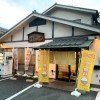 Eating Japanese katsudon once served in police interrogation rooms
Eating Japanese katsudon once served in police interrogation rooms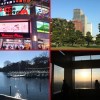 10 of our absolute favorite places to spend a day in Tokyo
10 of our absolute favorite places to spend a day in Tokyo Want big breasts? Japanese cosplayer shows how to boost your bust in seconds
Want big breasts? Japanese cosplayer shows how to boost your bust in seconds Disney princesses get official manga makeovers for Manga Princess Cafe opening in Tokyo
Disney princesses get official manga makeovers for Manga Princess Cafe opening in Tokyo More foreign tourists than ever before in history visited Japan last month
More foreign tourists than ever before in history visited Japan last month Starbucks reopens at Shibuya Scramble Crossing with new look and design concept
Starbucks reopens at Shibuya Scramble Crossing with new look and design concept Beautiful new Final Fantasy T-shirt collection on the way from Uniqlo【Photos】
Beautiful new Final Fantasy T-shirt collection on the way from Uniqlo【Photos】 Is the new Shinkansen Train Desk ticket worth it?
Is the new Shinkansen Train Desk ticket worth it? Foreign English teachers in Japan pick their favorite Japanese-language phrases【Survey】
Foreign English teachers in Japan pick their favorite Japanese-language phrases【Survey】 Japanese convenience store packs a whole bento into an onigiri rice ball
Japanese convenience store packs a whole bento into an onigiri rice ball We try out “Chan Ramen”, an underground type of ramen popular in the ramen community
We try out “Chan Ramen”, an underground type of ramen popular in the ramen community Studio Ghibli releases Kiki’s Delivery Service chocolate cake pouches in Japan
Studio Ghibli releases Kiki’s Delivery Service chocolate cake pouches in Japan Japan’s bone-breaking and record-breaking roller coaster is permanently shutting down
Japan’s bone-breaking and record-breaking roller coaster is permanently shutting down New definition of “Japanese whiskey” goes into effect to prevent fakes from fooling overseas buyers
New definition of “Japanese whiskey” goes into effect to prevent fakes from fooling overseas buyers Our Japanese reporter visits Costco in the U.S., finds super American and very Japanese things
Our Japanese reporter visits Costco in the U.S., finds super American and very Japanese things Studio Ghibli unveils Mother’s Day gift set that captures the love in My Neighbour Totoro
Studio Ghibli unveils Mother’s Day gift set that captures the love in My Neighbour Totoro Foreign passenger shoves conductor on one of the last full runs for Japan’s Thunderbird train
Foreign passenger shoves conductor on one of the last full runs for Japan’s Thunderbird train Domino’s Japan now sells…pizza ears?
Domino’s Japan now sells…pizza ears? New Japanese KitKat flavour stars Sanrio characters, including Hello Kitty
New Japanese KitKat flavour stars Sanrio characters, including Hello Kitty Kyoto creates new for-tourist buses to address overtourism with higher prices, faster rides
Kyoto creates new for-tourist buses to address overtourism with higher prices, faster rides Sales of Japan’s most convenient train ticket/shopping payment cards suspended indefinitely
Sales of Japan’s most convenient train ticket/shopping payment cards suspended indefinitely Sold-out Studio Ghibli desktop humidifiers are back so Totoro can help you through the dry season
Sold-out Studio Ghibli desktop humidifiers are back so Totoro can help you through the dry season Japanese government to make first change to romanization spelling rules since the 1950s
Japanese government to make first change to romanization spelling rules since the 1950s Ghibli founders Toshio Suzuki and Hayao Miyazaki contribute to Japanese whisky Totoro label design
Ghibli founders Toshio Suzuki and Hayao Miyazaki contribute to Japanese whisky Totoro label design Doraemon found buried at sea as scene from 1993 anime becomes real life【Photos】
Doraemon found buried at sea as scene from 1993 anime becomes real life【Photos】 Tokyo’s most famous Starbucks is closed
Tokyo’s most famous Starbucks is closed One Piece characters’ nationalities revealed, but fans have mixed opinions
One Piece characters’ nationalities revealed, but fans have mixed opinions We asked a Uniqlo employee what four things we should buy and their suggestions didn’t disappoint
We asked a Uniqlo employee what four things we should buy and their suggestions didn’t disappoint Princesses, fruits, and blacksmiths: Study reveals the 30 most unusual family names in Japan
Princesses, fruits, and blacksmiths: Study reveals the 30 most unusual family names in Japan Huge crowds gather for Halloween in Japan despite calls to stay home【Photos】
Huge crowds gather for Halloween in Japan despite calls to stay home【Photos】 Japanese YouTuber perfects gameplay moves outside Shibuya Station【Video】
Japanese YouTuber perfects gameplay moves outside Shibuya Station【Video】 Man strips, makes it rain atop stone lantern at Ise Jingu shrine in Japan
Man strips, makes it rain atop stone lantern at Ise Jingu shrine in Japan Otaku geek makeovers by Tokyo fashion expert go viral in Japan
Otaku geek makeovers by Tokyo fashion expert go viral in Japan Sailor Moon cosplay event in Tokyo provides costumes for all five Scouts, pro photographer
Sailor Moon cosplay event in Tokyo provides costumes for all five Scouts, pro photographer Shibuya 109 teams up with Hiroshima bread brand for “beary” cute cream pancakes and sandwiches
Shibuya 109 teams up with Hiroshima bread brand for “beary” cute cream pancakes and sandwiches First-ever Bon-Odori dance festival to be held at Shibuya scramble crossing for Obon
First-ever Bon-Odori dance festival to be held at Shibuya scramble crossing for Obon Tokyo’s Shibuya district bans public drinking on New Year’s Eve, cancels countdown celebration
Tokyo’s Shibuya district bans public drinking on New Year’s Eve, cancels countdown celebration Tokyo photo studio turns you into street samurai with armor photo shoot in the heart of downtown
Tokyo photo studio turns you into street samurai with armor photo shoot in the heart of downtown Brand new Shibuya mall and hotel to open in September, promises riverside strolls and tasty food
Brand new Shibuya mall and hotel to open in September, promises riverside strolls and tasty food Take a look at Japan from a whole new angle — from the air! 【Video】
Take a look at Japan from a whole new angle — from the air! 【Video】 Tokyo’s most famous video rental shop is shutting down
Tokyo’s most famous video rental shop is shutting down Sea urchin ramen – Not for the faint of heart!
Sea urchin ramen – Not for the faint of heart! The perfect place for a Tokyo catnap? Under the statue of Japan’s most famous dog, of course!
The perfect place for a Tokyo catnap? Under the statue of Japan’s most famous dog, of course! Tokyo’s newest mascot character: a smiling bright pink turd laid by Japan’s most famous dog【Vid】
Tokyo’s newest mascot character: a smiling bright pink turd laid by Japan’s most famous dog【Vid】
Leave a Reply